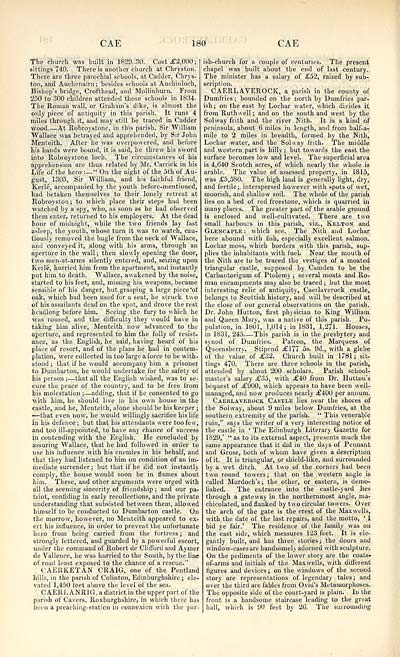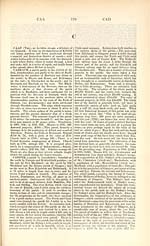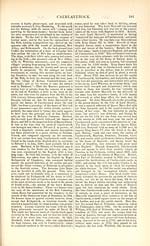Topographical, statistical, and historical gazetteer of Scotland > Volume 1
(260) Page 180
Download files
Complete book:
Individual page:
Thumbnail gallery: Grid view | List view

CAE
180
CAE
The church was built in 1829-30. Cost £2,000;
sittings 740. There is another church at Chryston.
There are three parochial schools, at Cadder, Chrys-
ton, and Auchenairn ; besides schools at Aucbinloch,
Bishop's bridge, Crofthead, and Mollinburn. From
250 to 300 children attended those schools in 1834.
The Roman wall, or Graham's dike, is almost the
only piece of antiquity in this parish. It runs 4
miles through it, and may still be traced in Cadder
wood. — At Robroystone, in this parish, Sir William
Wallace was betrayed and apprehended, by Sir John
Menteith. After he was overpowered, and before
his hands were bound, it is said, he threw his sword
into Robroystone loch. The circumstances of his
apprehension are thus related by Mr. Carrick in his
Life of the hero : — " On the night of the 5th of Au-
gust, 1305, Sir William, and bis faithful friend,
Kerle, accompanied by the youth before-mentioned,
had betaken themselves to their lonely retreat at
Robroyston ; to which place their steps had been
watched by a spy, who, as soon as he had observed
them enter, returned to his employers. At the dead
hour of midnight, while the two friends lay fast
asleep, the youth, whose turn it was to watch, cau-
tiously removed the bugle from the neck of Wallace,
and conveyed it, along with his arms, through an
apei'ture in the wall ; then slowly opening the door,
two men-at-arms silently entered, and, seizing upon
Kerle, hurried him from the apartment, and instantly
put him to death. Wallace, awakened by the noise,
started to his feet, and, missing his weapons, became
sensible of his danger, but grasping a large piece 'of
oak, which had been used for a seat, he struck two
of his assailants dead on the spot, and drove the rest
headlong before him. Seeing the fury to which he
was roused, and the difficulty they would have in
taking him alive, Menteith now advanced to the
aperture, and represented to him the folly of resist-
ance, as the English, he said, having heard of his
place of resort, and of the plans he had in contem-
plation, were collected in too large a force to be with-
stood ; that if he would accompany him a prisoner
to Dumbarton, he would undertake for the safety of
his person ; — that all the English wished, was to se-
cure the peace of the country, and to be free from
his molestation ; — adding, that if he consented to go
with him, he should live in his own house in the
castle, and he, Menteith, alone should be his keeper ;
• — that even now, he would willingly sacrifice his life
in his defence ; but that his attendants were too few,
and too ill-appointed, to have any chance of success
in contending with the English. He concluded by
assuring Wallace, that he had followed in order to
use his influence with his enemies in his behalf, and
that they had listened to him on condition of an im-
mediate surrender; but that if he did not instantly
comply, the house would soon be in flames about
him. These, and other arguments were urged with
all the seeming sincerity of friendship ; and our pa-
triot, confiding in early recollections, and the private
understanding that subsisted between them, allowed
himself to be conducted to Dumbarton castle. On
the morrow, however, no Menteith appeared to ex-
ert his influence, in order to prevent the unfortunate
hero from being carried from the fortress ; and
strongly fettered, and guarded by a powerful escort,
under the command of Robert de Clifford and Aymer
de Vallence, he was hurried to the South, by the line
of road least exposed to the chance of a rescue."
CAERKETAN CRAIG, one of the Pentland
hills, in the parish of Colinton, Edinburghshire ; ele-
vated 1,450 feet above the level of the sea.
CAERLANR1G, a district in the upper part of the
parish of Cavers. Roxburghshire, in which there has
been a preaching-staticn in connexion with the par-
ish-church for a couple of centuries. The present
chapel was built about the end of last century.
The minister has a salary of £52, raised by sub-
scription.
CAERLAVEROCK, a parish in the county of
Dumfries; bounded on the north by Dumfries par-
ish ; on the east by Lochar water, which divides it
from Ruthwell; and on the south and west by the
Solway frith and the river Nith. It is a kind of
peninsula, about 6 miles in length, and from half-a-
mile to 2 miles in breadth, formed by the Nith,
Lochar water, and the Solway frith. The middle
and western part is hilly; but towards the east the
surface becomes low and level. The superficial area
is 4,640 Scotch acres, of which nearly the whole is
arable. The value of assessed property, in 1815,
was £5,5S0. The high land is generally light, dry,
and fertile; interspersed however with spots of wet,
moorish, and shallow soil. The whole of the parish
lies on a bed of red freestone, which is quarried in
many places. The greater part of the arable ground
is enclosed and well-cultivated. There are two
small harbours in this parish, viz., Kelton and
Glencaple : which see. The Nith and Lochar
here abound with fish, especially excellent salmon.
Lochar moss, which borders with this parish, sup-
plies the inhabitants with fuel. Near the mouth of
the 'Nith are to be traced the vestiges of a moated
triangular castle, supposed by Camden to be the
Carbantorigum of Ptolemy ; several moats and Ro-
man encampments may also be traced ; but the most
interesting relic of antiquity, Caerlaverock castle,
belongs to Scottish history, and will be described at
the close of our general observations on the parish.
Dr. John Hutton, first physician to King William
and Queen Mary, was a native of this parish. Po-
pulation, in 1801, 1,014; in 1831, 1,271. Houses,
in 1831, 245 This parish is in the presbytery and
synod of Dumfries. Patron, the Marquess of
Queensberry. Stipend £177 5s. 9d„ with a glebe
of the value of £32. Church built in 1781 ; sit-
tings 470. There are three schools in the parish,
attended by about 200 scholars. Parish school-
master's salary £35, with £40 from Dr. Hutton's
bequest of £900, which appears to have been well-
managed, and now produces nearly £400 per annum.
Caerlaverock Castle lies near the shores of
the Solway, about 9 miles below Dumfries, at the
southern extremity of the parish. " This venerable
ruin," says the writer of a very interesting notice of
the castle in ' The Edinburgh Literary Gazette for
1S29,' "as to its external aspect, presents much the
same appearance that it did in the days of Pennant
and Grose, both of whom have given a description
of it. It is triangular, or shield-like, and surrounded
by a wet ditch. At two of the corners had been
two round towers; that on the western angle is
called Murdoch's; the other, or eastern, is demo-
lished. The entrance into the castle-yard lies
through a gateway in the northernmost angle, ma-
chicolated, and flanked by two circular towers. Over
the arch of the gate is the crest of the Maxwells,
with the date of the last repairs, and the motto, ' I
bid ye fair.' The residence of the family was on
the east side, which measures 123 feet. It is ele-
gantly built, and has three stories; the doors and
window-cases are handsomely adorned with sculpture.
On the pediments of the lower story are the coats-
of-arms and initials of the Maxwells, with different
figures and devices; on the windows of the second
story are representations of legendary tales; and
over the third are fables from Ovid's Metamorphoses.
The opposite side of the court-yard is plain. In the
front is a handsome staircase leading to the great
hall, which is SO feet by 26. The surrounding
180
CAE
The church was built in 1829-30. Cost £2,000;
sittings 740. There is another church at Chryston.
There are three parochial schools, at Cadder, Chrys-
ton, and Auchenairn ; besides schools at Aucbinloch,
Bishop's bridge, Crofthead, and Mollinburn. From
250 to 300 children attended those schools in 1834.
The Roman wall, or Graham's dike, is almost the
only piece of antiquity in this parish. It runs 4
miles through it, and may still be traced in Cadder
wood. — At Robroystone, in this parish, Sir William
Wallace was betrayed and apprehended, by Sir John
Menteith. After he was overpowered, and before
his hands were bound, it is said, he threw his sword
into Robroystone loch. The circumstances of his
apprehension are thus related by Mr. Carrick in his
Life of the hero : — " On the night of the 5th of Au-
gust, 1305, Sir William, and bis faithful friend,
Kerle, accompanied by the youth before-mentioned,
had betaken themselves to their lonely retreat at
Robroyston ; to which place their steps had been
watched by a spy, who, as soon as he had observed
them enter, returned to his employers. At the dead
hour of midnight, while the two friends lay fast
asleep, the youth, whose turn it was to watch, cau-
tiously removed the bugle from the neck of Wallace,
and conveyed it, along with his arms, through an
apei'ture in the wall ; then slowly opening the door,
two men-at-arms silently entered, and, seizing upon
Kerle, hurried him from the apartment, and instantly
put him to death. Wallace, awakened by the noise,
started to his feet, and, missing his weapons, became
sensible of his danger, but grasping a large piece 'of
oak, which had been used for a seat, he struck two
of his assailants dead on the spot, and drove the rest
headlong before him. Seeing the fury to which he
was roused, and the difficulty they would have in
taking him alive, Menteith now advanced to the
aperture, and represented to him the folly of resist-
ance, as the English, he said, having heard of his
place of resort, and of the plans he had in contem-
plation, were collected in too large a force to be with-
stood ; that if he would accompany him a prisoner
to Dumbarton, he would undertake for the safety of
his person ; — that all the English wished, was to se-
cure the peace of the country, and to be free from
his molestation ; — adding, that if he consented to go
with him, he should live in his own house in the
castle, and he, Menteith, alone should be his keeper ;
• — that even now, he would willingly sacrifice his life
in his defence ; but that his attendants were too few,
and too ill-appointed, to have any chance of success
in contending with the English. He concluded by
assuring Wallace, that he had followed in order to
use his influence with his enemies in his behalf, and
that they had listened to him on condition of an im-
mediate surrender; but that if he did not instantly
comply, the house would soon be in flames about
him. These, and other arguments were urged with
all the seeming sincerity of friendship ; and our pa-
triot, confiding in early recollections, and the private
understanding that subsisted between them, allowed
himself to be conducted to Dumbarton castle. On
the morrow, however, no Menteith appeared to ex-
ert his influence, in order to prevent the unfortunate
hero from being carried from the fortress ; and
strongly fettered, and guarded by a powerful escort,
under the command of Robert de Clifford and Aymer
de Vallence, he was hurried to the South, by the line
of road least exposed to the chance of a rescue."
CAERKETAN CRAIG, one of the Pentland
hills, in the parish of Colinton, Edinburghshire ; ele-
vated 1,450 feet above the level of the sea.
CAERLANR1G, a district in the upper part of the
parish of Cavers. Roxburghshire, in which there has
been a preaching-staticn in connexion with the par-
ish-church for a couple of centuries. The present
chapel was built about the end of last century.
The minister has a salary of £52, raised by sub-
scription.
CAERLAVEROCK, a parish in the county of
Dumfries; bounded on the north by Dumfries par-
ish ; on the east by Lochar water, which divides it
from Ruthwell; and on the south and west by the
Solway frith and the river Nith. It is a kind of
peninsula, about 6 miles in length, and from half-a-
mile to 2 miles in breadth, formed by the Nith,
Lochar water, and the Solway frith. The middle
and western part is hilly; but towards the east the
surface becomes low and level. The superficial area
is 4,640 Scotch acres, of which nearly the whole is
arable. The value of assessed property, in 1815,
was £5,5S0. The high land is generally light, dry,
and fertile; interspersed however with spots of wet,
moorish, and shallow soil. The whole of the parish
lies on a bed of red freestone, which is quarried in
many places. The greater part of the arable ground
is enclosed and well-cultivated. There are two
small harbours in this parish, viz., Kelton and
Glencaple : which see. The Nith and Lochar
here abound with fish, especially excellent salmon.
Lochar moss, which borders with this parish, sup-
plies the inhabitants with fuel. Near the mouth of
the 'Nith are to be traced the vestiges of a moated
triangular castle, supposed by Camden to be the
Carbantorigum of Ptolemy ; several moats and Ro-
man encampments may also be traced ; but the most
interesting relic of antiquity, Caerlaverock castle,
belongs to Scottish history, and will be described at
the close of our general observations on the parish.
Dr. John Hutton, first physician to King William
and Queen Mary, was a native of this parish. Po-
pulation, in 1801, 1,014; in 1831, 1,271. Houses,
in 1831, 245 This parish is in the presbytery and
synod of Dumfries. Patron, the Marquess of
Queensberry. Stipend £177 5s. 9d„ with a glebe
of the value of £32. Church built in 1781 ; sit-
tings 470. There are three schools in the parish,
attended by about 200 scholars. Parish school-
master's salary £35, with £40 from Dr. Hutton's
bequest of £900, which appears to have been well-
managed, and now produces nearly £400 per annum.
Caerlaverock Castle lies near the shores of
the Solway, about 9 miles below Dumfries, at the
southern extremity of the parish. " This venerable
ruin," says the writer of a very interesting notice of
the castle in ' The Edinburgh Literary Gazette for
1S29,' "as to its external aspect, presents much the
same appearance that it did in the days of Pennant
and Grose, both of whom have given a description
of it. It is triangular, or shield-like, and surrounded
by a wet ditch. At two of the corners had been
two round towers; that on the western angle is
called Murdoch's; the other, or eastern, is demo-
lished. The entrance into the castle-yard lies
through a gateway in the northernmost angle, ma-
chicolated, and flanked by two circular towers. Over
the arch of the gate is the crest of the Maxwells,
with the date of the last repairs, and the motto, ' I
bid ye fair.' The residence of the family was on
the east side, which measures 123 feet. It is ele-
gantly built, and has three stories; the doors and
window-cases are handsomely adorned with sculpture.
On the pediments of the lower story are the coats-
of-arms and initials of the Maxwells, with different
figures and devices; on the windows of the second
story are representations of legendary tales; and
over the third are fables from Ovid's Metamorphoses.
The opposite side of the court-yard is plain. In the
front is a handsome staircase leading to the great
hall, which is SO feet by 26. The surrounding
Set display mode to: Large image | Transcription
Images and transcriptions on this page, including medium image downloads, may be used under the Creative Commons Attribution 4.0 International Licence unless otherwise stated. ![]()
| Gazetteers of Scotland, 1803-1901 > Topographical, statistical, and historical gazetteer of Scotland > Volume 1 > (260) Page 180 |
|---|
| Permanent URL | https://digital.nls.uk/97440666 |
|---|
| Description | Volume first. A-H. |
|---|---|
| Attribution and copyright: |
|

